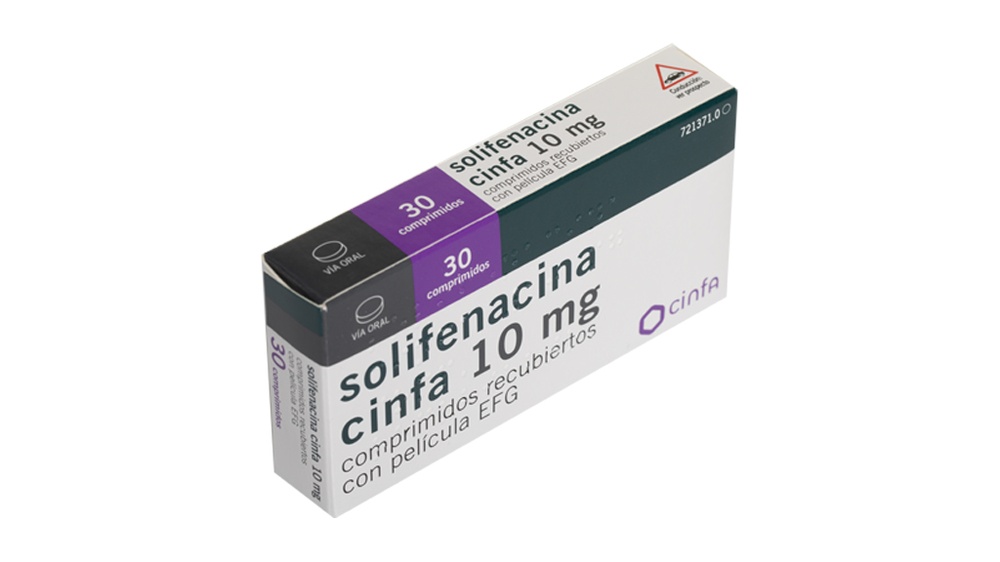

СОЛИФЕНАЦИН ЦИНФА 10 мг ТАБЛЕТКИ, ПОКРЫТЫЕ ПЛЁНОЧНОЙ ОБОЛОЧКОЙ

Спросите врача о рецепте на СОЛИФЕНАЦИН ЦИНФА 10 мг ТАБЛЕТКИ, ПОКРЫТЫЕ ПЛЁНОЧНОЙ ОБОЛОЧКОЙ

Инструкция по применению СОЛИФЕНАЦИН ЦИНФА 10 мг ТАБЛЕТКИ, ПОКРЫТЫЕ ПЛЁНОЧНОЙ ОБОЛОЧКОЙ
Введение
Инструкция: информация для пользователя
солифенацина цинфа 10 мг таблетки, покрытые пленкой ЕФГ
солифенацина сукцинат
Прочитайте внимательно всю инструкцию перед началом приема этого лекарства, поскольку она содержит важную информацию для вас.
- Сохраните эту инструкцию, поскольку вам может потребоваться прочитать ее снова.
Если у вас есть какие-либо вопросы, проконсультируйтесь с вашим врачом или фармацевтом.
- Это лекарство было назначено только вам, и не следует давать его другим людям, даже если у них такие же симптомы, как у вас, поскольку оно может причинить им вред.
- Если вы испытываете побочные эффекты, проконсультируйтесь с вашим врачом или фармацевтом, даже если это побочные эффекты, которые не указаны в этой инструкции. См. раздел 4.
Содержание инструкции
- Что такое солифенацина цинфа и для чего она используется
- Что вам нужно знать перед началом приема солифенацины цинфы
- Как принимать солифенацину цинфу
- Возможные побочные эффекты
5 Хранение солифенацины цинфы
- Содержание упаковки и дополнительная информация
1. Что такое солифенацина цинфа и для чего она используется
Активное вещество солифенацины цинфы относится к группе антихолинергических препаратов. Эти лекарства используются для снижения активности гиперактивной мочевого пузыря. Это позволяет вам иметь больше времени перед тем, как вам нужно пойти в туалет, и увеличивает количество мочи, которое ваш мочевой пузырь может удерживать.
Солифенацина цинфа используется для лечения симптомов гиперактивного мочевого пузыря. Эти симптомы включают: сильную и внезапную необходимость мочиться без предупреждения, частое мочеиспускание или недержание мочи из-за неспособности добраться до туалета вовремя.
2. Что вам нужно знать перед началом приема солифенацины цинфы
Не принимайте солифенацину цинфу
- если вы аллергичны к солифенацине или к любому другому компоненту этого лекарства (указанному в разделе 6).
- если у вас есть трудности с мочеиспусканием или с полным опорожнением мочевого пузыря (задержка мочи)
- если у вас есть тяжелое расстройство желудка или кишечника (включая токсический мегаколон, осложнение, связанное с язвенным колитом)
- если у вас есть мышечное заболевание, называемое миастенией гравис, которое может вызывать чрезмерную слабость определенных мышц
- если у вас есть заболевание глаз, называемое глаукомой, с постепенной потерей зрения
- если вы проходите диализ почек
- если у вас есть тяжелое заболевание печени
- если у вас есть тяжелое заболевание почек или умеренное заболевание печени и одновременно вы принимаете лекарства, которые могут снижать выведение солифенацины из организма (например, кетоконазол). Ваш врач или фармацевт проинформирует вас, если это так.
Прежде чем начать лечение солифенациной, сообщите вашему врачу, если у вас есть или были какие-либо из вышеуказанных заболеваний.
Предостережения и меры предосторожности
Проконсультируйтесь с вашим врачом или фармацевтом перед началом приема солифенацины
- если у вас есть проблемы с опорожнением мочевого пузыря (= обструкция мочевого пузыря) или с мочеиспусканием (например, слабый поток мочи). Риск задержки мочи в мочевом пузыре значительно выше.
- если у вас есть обструкция пищеварительной системы (запор).
- если у вас есть повышенный риск снижения активности пищеварительной системы (движения желудка и кишечника). Ваш врач проинформирует вас, если это так.
- если у вас есть тяжелое заболевание почек.
- если у вас есть умеренное заболевание печени.
- если у вас есть грыжа пищевода или изжога.
- если у вас есть нервное расстройство (автономная нейропатия).
Дети и подростки
Сообщите вашему врачу перед началом лечения солифенациной, если какие-либо из вышеуказанных обстоятельств когда-либо发生ались с вами.
Солифенацина не должна использоваться у детей и подростков младше 18 лет.
Прежде чем начать лечение солифенациной, ваш врач оценит, есть ли другие причины вашей частой необходимости мочиться (например, сердечная недостаточность или заболевание почек). Если у вас есть инфекция мочевыделительной системы, ваш врач назначит вам антибиотик (лечение против определенных бактериальных инфекций).
Прием солифенацины цинфы с другими лекарствами
Сообщите вашему врачу или фармацевту, если вы принимаете или最近 принимали любое другое лекарство.
Особенно важно, чтобы вы сообщили вашему врачу, если вы принимаете:
- другие антихолинергические препараты, активность и побочные эффекты которых могут увеличиться.
- холинергические препараты, поскольку они могут снижать эффект солифенацины.
- препараты, такие как метоклопрамид или цисаприд, которые ускоряют работу пищеварительной системы. Солифенацина может снижать их эффект.
- препараты, такие как кетоконазол, ритонавир, нельфинавир, итраконазол, верапамил и дилтиазем, которые снижают скорость выведения солифенацины из организма.
- препараты, такие как рифампицин, фенитоин и карбамазепин, поскольку они могут увеличить скорость выведения солифенацины из организма.
- препараты, такие как бисфосфонаты, которые могут вызывать или ухудшать воспаление пищевода (эзофагит).
Прием солифенацины цинфы с пищей и напитками
Солифенацина цинфа может приниматься с пищей или без нее, по вашему желанию.
Беременность, лактация и фертильность
Не используйте солифенацину, если вы беременны,unless это абсолютно необходимо. Не используйте солифенацину во время лактации, поскольку солифенацина может проникать в грудное молоко.
Если вы беременны или в период лактации, считаете, что могли бы быть беременной или планируете стать беременной, проконсультируйтесь с вашим врачом или фармацевтом перед использованием этого лекарства.
Вождение и использование машин
Солифенацина может вызывать размытое зрение и иногда сонливость или усталость. Если вы испытываете любой из этих побочных эффектов, не驾驶айте транспортные средства и не используйте машины.
3. Как принимать солифенацину цинфу
Инструкции для правильного использования
Следуйте точно инструкциям по приему этого лекарства, указанным вашим врачом. В случае сомнений проконсультируйтесь с вашим врачом или фармацевтом.
Вам необходимо проглотить таблетку целиком с некоторым количеством жидкости. Ее можно принимать с пищей или без нее, по вашему желанию. Не разжевывайте таблетки.
Обычная доза составляет 5 мг в день, unless ваш врач указал вам принимать 10 мг в день.
Если вы приняли слишком много солифенацины цинфы
В случае передозировки или случайного приема проконсультируйтесь немедленно с вашим врачом или фармацевтом или позвоните в Службу токсикологической информации, телефон 91 562 04 20, указав лекарство и количество, принятое.
Симптомы при передозировке могут включать: головную боль, сухость во рту, головокружение, сонливость и размытое зрение, восприятие вещей, которых нет (галлюцинации), сильное возбуждение, судороги, затруднение дыхания, увеличение частоты сердечных сокращений (тахикардия), задержку мочи в мочевом пузыре (задержка мочи) и расширение зрачков (мидриаз).
Если вы пропустили прием солифенацины цинфы
Если вы забыли принять дозу в обычное время, примите ее как можно скорее, unless это время для приема следующей дозы. Никогда не принимайте более одной дозы в день.
Если вы прекратили лечение солифенациной цинфой
Если вы прекратите принимать солифенацину цинфу, ваши симптомы гиперактивного мочевого пузыря могут вернуться или ухудшиться. Проконсультируйтесь всегда с вашим врачом, если вы думаете прекратить лечение.
Если у вас есть какие-либо другие вопросы о использовании этого лекарства, проконсультируйтесь с вашим врачом или фармацевтом.
4. Возможные побочные эффекты
Как и все лекарства, это лекарство может вызывать побочные эффекты, хотя не все люди их испытывают.
Если вы испытываете аллергическую реакцию или тяжелую кожную реакцию (например, образование пузырей и шелушение кожи), сообщите вашему врачу или медсестре немедленно.
Было сообщено об ангиедеме (аллергии на коже, которая приводит к воспалению, происходящему в ткани под поверхностью кожи) с обструкцией дыхательных путей (затруднением дыхания) у некоторых пациентов, леченных сукцинатом солифенацины. Если появляется ангиедем, лечение сукцинатом солифенацины должно быть немедленно прекращено и должны быть приняты соответствующие меры.
Солифенацина цинфа может вызывать следующие побочные эффекты:
Очень часто (могут возникать у более 1 из 10 человек)
- сухость во рту
Часто (могут возникать у до 1 из 10 человек)
- размытое зрение
- запор, тошнота, диспепсия с симптомами, такими как чувство тяжести в желудке, боль в животе, отрыжка, тошнота и изжога
Побочные эффекты, возникающие редко (могут возникать у до 1 из 100 человек)
- инфекция мочевыделительной системы, инфекция мочевого пузыря
- сонливость
- нарушение вкуса (дисгевзия)
- сухость глаз (ирритация)
- сухость носовых проходов
- рефлюкс-эзофагит
- сухость горла
- сухость кожи
- затруднение мочеиспускания
- усталость
- отеки на нижних конечностях (эдема)
Побочные эффекты, возникающие очень редко (могут возникать у до 1 из 1000 человек)
- закупорка кишечника (фекальная импакция)
- задержка мочи в мочевом пузыре (задержка мочи)
- головокружение, головная боль
- рвота
- зуд, кожная сыпь
Побочные эффекты, возникающие чрезвычайно редко (могут возникать у до 1 из 10 000 человек)
- галлюцинации, конфузия
- аллергическая кожная реакция.
Частота не известна (частота не может быть оценена на основе доступных данных)
- понижение аппетита, высокие уровни калия в крови, которые могут вызывать аномальный сердечный ритм.
- повышение давления в глазах
- изменения электрической активности сердца (ЭКГ), аритмия, перебои в работе сердца, тахикардия.
- нарушение голоса
- нарушение функции печени
- мышечная слабость
- нарушение функции почек
Сообщение о побочных эффектах
Если вы испытываете любой побочный эффект, проконсультируйтесь с вашим врачом или фармацевтом, даже если это возможные побочные эффекты, которые не указаны в этой инструкции. Вы также можете сообщить об этом напрямую через Систему фармаковигиланса лекарственных средств для человека: https://www.notificaram.es. Сообщая о побочных эффектах, вы можете внести свой вклад в предоставление более полной информации о безопасности этого лекарства.
5. Хранение солифенацины цинфы
Храните это лекарство в недоступном для детей месте.
Не используйте это лекарство после даты истечения срока годности, указанной на упаковке после "CAD". Дата истечения срока годности - последний день месяца, указанного.
Не храните при температуре выше 30 °C.
Лекарства не должны выбрасываться в канализацию или мусор. Положите упаковку и лекарства, которые вам больше не нужны, в punto SIGRE аптеки. Если у вас есть сомнения, проконсультируйтесь с вашим фармацевтом, как избавиться от упаковки и лекарств, которые вам больше не нужны. Таким образом, вы поможете защитить окружающую среду.
6. Содержание упаковки и дополнительная информация
Состав солифенацины цинфы
- Активное вещество - сукцинат солифенацины: 10 мг.
- Другие компоненты - повидон, кукурузный крахмал, карбоксиметилкрахмал натрия (тип А), дигидрофосфат кальция, стеарат магния, опадри белый и оксид железа красный (Е172).
Внешний вид продукта и содержание упаковки
Таблетки солифенацины цинфы 10 мг - это таблетки, покрытые пленкой, цилиндрические, двояковыпуклые, светло-розового цвета, без риски и с логотипом "S1" на одной стороне.
Таблетки солифенацины цинфы 10 мг поставляются в блистерах по 30 таблеток.
Владелец разрешения на продажу и负责ная организация
Лаборатории Cinfa, S.A.
Carretera Olaz-Chipi, 10. Полигон Индустриал Арета.
31620 Уарте (Наварра) - Испания
Дата последней ревизии этой инструкции:Апрель 2018
Подробная информация о этом лекарстве доступна на сайте Агентства по лекарственным средствам и медицинским изделиям Испании (AEMPS) http://www.aemps.gob.es
Вы можете получить доступ к подробной и актуальной информации о этом лекарстве, отсканировав код QR, включенный в инструкцию и упаковку, с помощью вашего мобильного телефона (смартфона). Вы также можете получить доступ к этой информации на сайте: https://cima.aemps.es/cima/dochtml/p/83023/P_83023.html
Код QR: https://cima.aemps.es/cima/dochtml/p/83023/P_83023.html

Сколько стоит СОЛИФЕНАЦИН ЦИНФА 10 мг ТАБЛЕТКИ, ПОКРЫТЫЕ ПЛЁНОЧНОЙ ОБОЛОЧКОЙ в Испании в 2025 году?
Средняя цена на СОЛИФЕНАЦИН ЦИНФА 10 мг ТАБЛЕТКИ, ПОКРЫТЫЕ ПЛЁНОЧНОЙ ОБОЛОЧКОЙ в декабрь, 2025 года составляет около 40.81 евро. Финальная стоимость может зависеть от региона, конкретной аптеки и рецептурного статуса. Для точной информации лучше проверить онлайн или в ближайшей аптеке.
- Страна регистрации
- Средняя цена в аптеках40.81 EUR
- Активное вещество
- Требуется рецептДа
- Производитель
- Информация носит справочный характер и не является медицинской рекомендацией. Перед приемом любых препаратов проконсультируйтесь с врачом. Oladoctor не несет ответственности за медицинские решения, принятые на основе этого контента.
- Аналоги СОЛИФЕНАЦИН ЦИНФА 10 мг ТАБЛЕТКИ, ПОКРЫТЫЕ ПЛЁНОЧНОЙ ОБОЛОЧКОЙФорма выпуска: ТАБЛЕТКА, 10 мгАктивное вещество: солифенацинПроизводитель: Laboratorios Alter S.A.Требуется рецептФорма выпуска: ТАБЛЕТКА, 5 мгАктивное вещество: солифенацинПроизводитель: Laboratorios Alter S.A.Требуется рецептФорма выпуска: ТАБЛЕТКА, 10 мгАктивное вещество: солифенацинПроизводитель: Laboratorios Q Pharma S.L.Требуется рецепт
Аналоги СОЛИФЕНАЦИН ЦИНФА 10 мг ТАБЛЕТКИ, ПОКРЫТЫЕ ПЛЁНОЧНОЙ ОБОЛОЧКОЙ в других странах
Лучшие аналоги с тем же действующим веществом и терапевтическим эффектом.
Аналог СОЛИФЕНАЦИН ЦИНФА 10 мг ТАБЛЕТКИ, ПОКРЫТЫЕ ПЛЁНОЧНОЙ ОБОЛОЧКОЙ в Польша
Аналог СОЛИФЕНАЦИН ЦИНФА 10 мг ТАБЛЕТКИ, ПОКРЫТЫЕ ПЛЁНОЧНОЙ ОБОЛОЧКОЙ в Украина
Врачи онлайн по СОЛИФЕНАЦИН ЦИНФА 10 мг ТАБЛЕТКИ, ПОКРЫТЫЕ ПЛЁНОЧНОЙ ОБОЛОЧКОЙ
Консультация по дозировке, побочным эффектам, взаимодействиям, противопоказаниям и продлению рецепта на СОЛИФЕНАЦИН ЦИНФА 10 мг ТАБЛЕТКИ, ПОКРЫТЫЕ ПЛЁНОЧНОЙ ОБОЛОЧКОЙ – по решению врача и с учетом местных правил.






